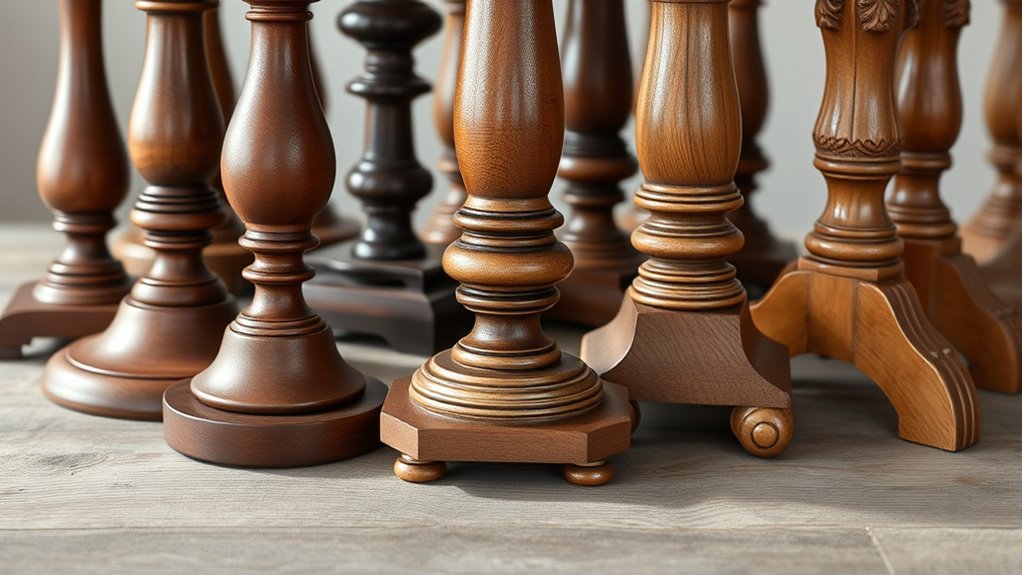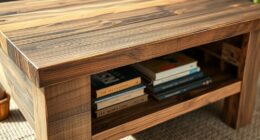Turned table legs add style and craftsmanship to your furniture, offering a variety of shapes and designs from ornate Victorian to simple Shaker styles. You can source them from specialty suppliers in different woods or opt for custom-made options to match your project’s look. Antique or vintage legs can add authenticity, but may be harder to find. Explore the different styles and sourcing options further to create beautiful, authentic pieces that stand out.
Key Takeaways
- Explore various styles like Queen Anne, Victorian, Shaker, and Mission to match your furniture design.
- Use a lathe and traditional or modern tools to craft or restore turned table legs with precision.
- Source from specialty suppliers offering a range of woods and custom options or repurpose vintage legs.
- Understand historical influences to select or create legs that enhance your furniture’s aesthetic.
- Consider style, function, and craftsmanship to achieve authentic and visually appealing turned legs.

Turned table legs are a classic feature that can transform the look of any piece of furniture. They add a sense of craftsmanship and style that’s hard to achieve with simple, straight legs. Whether you’re restoring an antique or crafting a new piece, understanding the different styles and sourcing options for turned table legs can make all the difference. The key to creating or selecting the right legs lies in knowing about woodworking techniques and the influence of historical designs.
When working with woodworking techniques, you’ll find that turning legs involves a combination of precision and skill. The process typically uses a lathe, which spins the wood while you shape it with chisels and gouges. This method allows you to create smooth, symmetrical curves and intricate details that give each leg its unique character. Modern tools have made this process more accessible, but traditional hand-turning remains popular for authentic, handcrafted results. If you’re interested in replicating historical designs, learning specific woodworking techniques used in different eras is essential. For example, Victorian-style legs often feature elaborate carvings and bulbous shapes, while Shaker or Mission styles favor simpler, clean lines. By understanding these techniques and design principles, you can either craft your own legs to match a particular aesthetic or identify authentic pieces when sourcing. Additionally, understanding the influence of historical designs can help you select or create turned legs that perfectly complement your furniture style.
Sourcing turned table legs can be approached in several ways. You might choose to purchase ready-made legs from specialty suppliers, which offer a wide range of styles inspired by different periods and design philosophies. These suppliers often stock legs made from various woods, such as oak, cherry, or maple, giving you options to match the existing furniture or your desired look. Alternatively, if you prefer a more authentic or personalized touch, you can craft your own legs using woodworking techniques suited to your skill level. This approach allows greater customization in terms of shape, size, and decorative details. Restorers and vintage furniture enthusiasts often find that sourcing antique or vintage turned legs adds authenticity to their projects, but these can sometimes be hard to find or expensive.
Whether you choose to buy or craft, understanding the historical designs that influence turned legs can guide your decision-making. For instance, the turned legs of Queen Anne furniture feature elegant, slender shapes with subtle curves, reminiscent of the 18th century. During the Victorian era, legs became more ornate and elaborate, emphasizing craftsmanship and decorative appeal. Knowing these styles helps you select legs that enhance your furniture’s overall aesthetic. Ultimately, the art of sourcing turned table legs combines an appreciation for historical designs with practical knowledge of woodworking techniques, allowing you to create or find pieces that are both beautiful and functional.
Frequently Asked Questions
What Are the Most Durable Woods for Turned Table Legs?
You’ll find that hardwoods like oak, maple, and ash are the most durable for turned table legs because of their tight wood grain, which resists splitting and impacts. When choosing wood, consider finishing techniques like staining or sealing to enhance durability and appearance. These methods protect the wood, ensuring your turned legs stay strong and beautiful over time, even with regular use.
How Do I Maintain and Clean Turned Wooden Legs?
Think of your turned wooden legs as a well-loved treasure that needs gentle care. To maintain and clean them, regularly dust with a soft cloth, then use polishing techniques with a quality furniture polish to bring out their shine. For stain removal, lightly dampen a cloth with a mixture of mild soap and water, then wipe gently. Avoid harsh chemicals to preserve their beauty and durability.
Can Turned Legs Be Customized for Specific Table Designs?
Yes, turned legs can be customized to match your specific table design. With various customization options, you can choose different wood types, sizes, and intricate details to suit your style. This flexibility offers great design flexibility, allowing you to create unique pieces that perfectly fit your vision. Whether you want a traditional, modern, or eclectic look, customizing turned legs helps bring your custom table design to life.
Are There Eco-Friendly Options for Sourcing Turned Table Legs?
You can definitely find eco-friendly turned table legs, and it’s worth exploring sustainable wood sources like reclaimed wood or FSC-certified materials. These options help you stay green without sacrificing style. Pair them with eco-friendly finishing methods, such as natural oils or water-based paints, to keep your project environmentally conscious. Think of it as hitting two birds with one stone—creating beautiful furniture while caring for the planet.
How Do I Measure for the Correct Size of Turned Legs?
To measure for the correct size of turned legs, use measuring techniques like a tape measure or calipers for leg length accuracy. First, determine the desired height of your table, then measure from the tabletop surface to the floor, subtracting any thickness of the tabletop. Double-check your measurements to guarantee precision, as accurate measurements prevent wobbling and ensure your turned legs fit perfectly for a sturdy, balanced table.
Conclusion
Now that you’ve explored the variety of turned table leg styles, imagine your table transforming into a centerpiece of timeless elegance. With a simple choice of intricately carved or smoothly rounded legs, you bring character and warmth to your space. As you select the perfect source, picture your table standing proudly, its legs like delicate sculptures supporting memories and conversations. Your perfect table awaits—crafted to inspire and last for generations.









